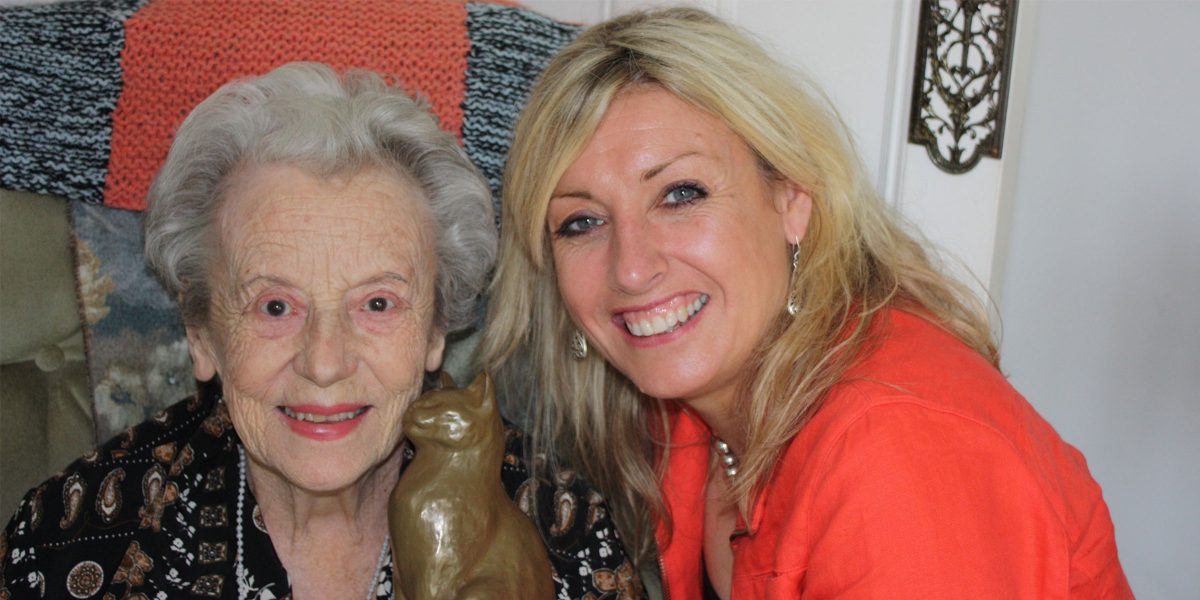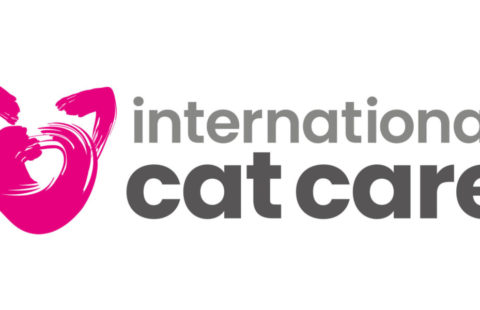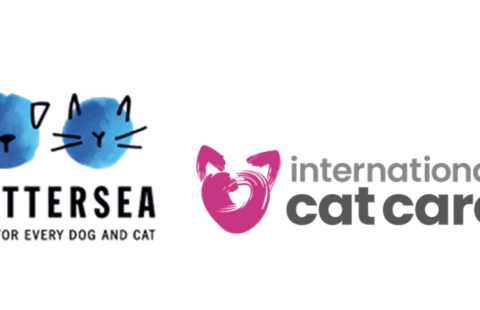The theme of this year’s International Women’s Day is ‘Each for Equal’, and the International Women’s Day website states that ‘We can actively choose to challenge stereotypes, fight bias, broaden perceptions, improve situations and celebrate women’s achievements.’ The history of International Cat Care begins with a woman who mirrored these actions by spending a lifetime challenging stereotypes, fighting bias, broadening perceptions and improving situations for cats across the world, and so, on International Women’s Day 2020, we are celebrating the achievements of Joan Judd.
Nowadays we take it for granted that our cats are looked after properly. If they’re unwell we can take them to the vet and be confident that they’ll be diagnosed and given appropriate treatment, and if we need to leave them for any length of time in a boarding cattery or pet hotel we can expect them to be properly equipped to care for them. It’s hard to imagine that it could have been any other way, but just 60 years ago the situation for cats was vastly different, and had it not been for the incredible efforts of Joan Judd, the world might be a very different place for cats today.
Joan was born in 1915 and grew up in Gloucestershire where her parents and grandparents bred horses. She was surrounded by cats from her earliest days, they were kept in the stables to control the population of rats, and she often made pets of the kittens that she’d find amongst the hay. Her early ambition was to be a vet, but although the financial slump of the 1920s and 1930s made this dream impossible, her interest in animal welfare continued. When she was given two Siamese cats by her husband, she set out to learn as much about the breed and their proper care as she could.
As Joan became more familiar with the world of cat breeding and keeping, she began to notice frequent letters in dedicated magazines that complained of the lack of veterinary knowledge of cat ailments. Concerns about this were widespread, but nobody seemed interested in taking responsibility for driving change. Cat clubs at the time were primarily concerned with organising shows and events and were more of a social club than anything to do with feline welfare. Her frustration mounted at the apathy she found within these circles and she decided that she must do something herself. In 1958 Joan founded the Feline Advisory Bureau (FAB), as International Cat Care was then called. Alongside FAB, Joan also founded a subsidiary organisation, the Central Fund for Feline Research (CFFR), to support feline studies at universities with funds that were kept separate from those of FAB.
The task in front of Joan and FAB was huge. The veterinary profession was very different from the industry we know today. Until 1960 95% of vets were men, and at the time of FAB’s foundation they were still primarily concerned with livestock and horses. The British Small Animal Veterinary Association had only been founded in 1957 and vets specialising in the care of small animals were a minority. Even amongst those specialists, dogs were the main concern and almost nothing was known about cats. At the time, opportunities to research feline medicine simply didn’t exist. Progress couldn’t be made without dedicated study, but it was prohibitively expensive. Cats just weren’t seen as being worth the investment and thus their situation was at a standstill. FAB had put themselves at the forefront of changing this.
In the first issue of the monthly news bulletin that FAB distributed to its members, the Vice-President at the time Mrs Doreen Tovey, writes of how her two Siamese cats ‘contracted a mysterious virus infection, from which, thanks to modern drugs and the attention of a good veterinary surgeon, they have now recovered.’ She goes on to state that ‘The knowledge that these things can be done cannot be too widely advertised’. This encapsulates the early challenges almost perfectly, few illness affecting cats were anything other than a ‘mystery’ and the established thinking at the time was that there was little worth doing, and even less that could be done.
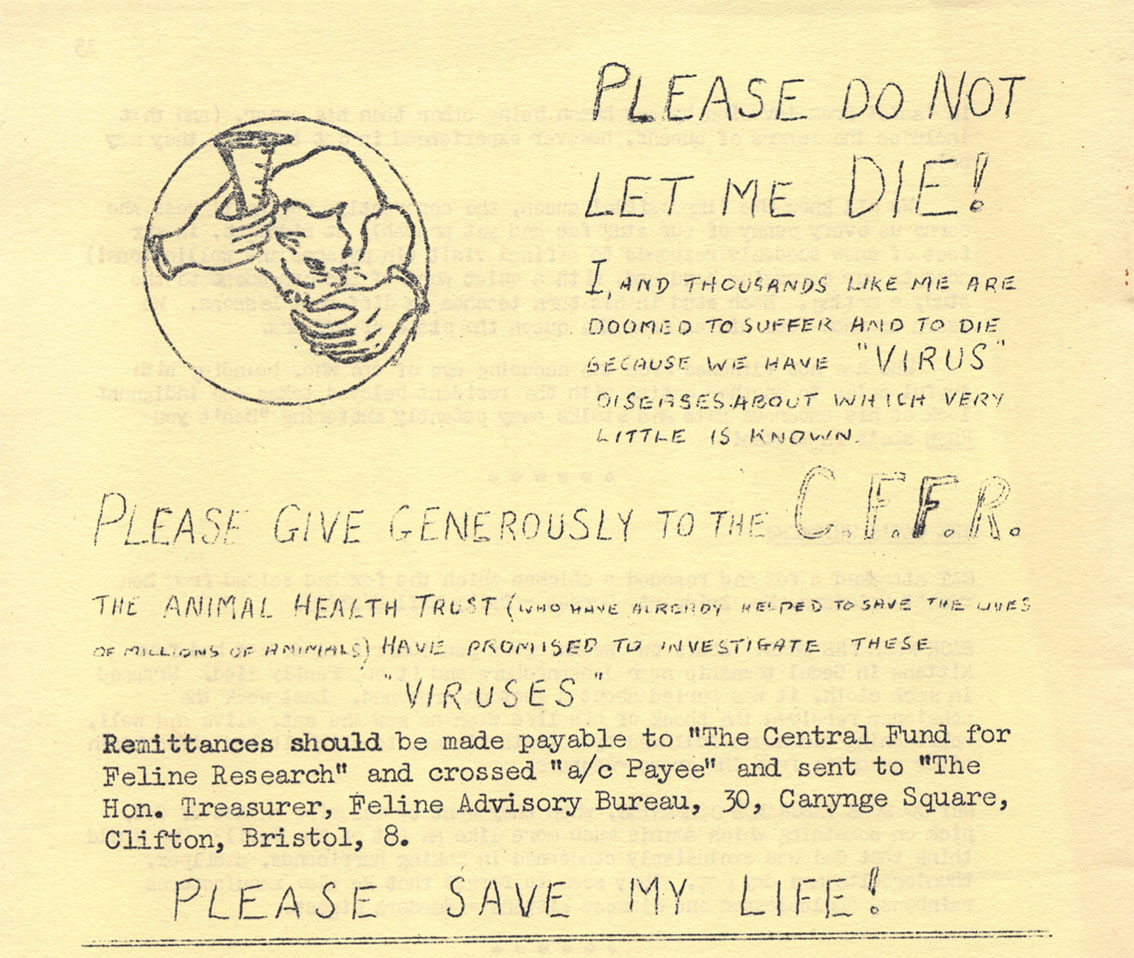
It’s hard to overstate how little was known about the proper care of cats in the early part of the twentieth century. There was next to no knowledge of cat diseases and in the 1920s problems were attributed to ‘distemper’, or ‘poisoning’ if symptoms were more severe. Even by the 1960s things had hardly improved, few diseases had been identified and there were even fewer treatments available. At that time there was only one inoculation for cats. Information was so scarce that the bureau began conducting studies themselves. Cat owners and breeders were asked to send in (washed) worms that had been passed naturally by the cat or kitten so that the most common species of internal parasite could be established.
At the first meeting of the Feline Advisory Bureau, Joan stated that ‘There has never before existed an organisation devised specifically with the object of the dissemination of knowledge, information and education in ALL matters dealing with the cat’. This sudden establishment of a central service that dealt with the countless subjects affecting cats was met with a wave of interest from cat lovers and breeders across the United Kingdom. Hundreds of letters on all sorts of topics arrived and some of the early responses given out by FAB in the early days illustrates how little was known even among the passionate owners and breeders. One reader wrote in to ask ‘What exactly happens if we have anything die of something mysterious, do we send the corpse to you?’ and people frequently asked whether they were being ‘silly’ or ‘a nuisance’ when consulting a vet over an issue affecting their cat.
Joan and the FAB volunteers were working flat out to compile a central hub of information from vets and other breeders. As the pool of knowledge was so dilute, it was an unimaginably vast project to collect the information that was scattered nationally and internationally. Correspondence quickly spread overseas and even by 1963 international interest had grown and the charity was in contact with 9 different countries.
Creating this library of information involved a huge physical collection of papers which could be sent for or borrowed. Compiling the knowledge that already existed was a great start, but Joan and the FAB knew that further study and well-planned scientific investigations were essential for making progress towards a world where cats were cared for properly. To do work of this kind was expensive, and at the time even the day to day running of the charity was a huge strain on their finances.
In the early FAB journals donations of stamps were requested to ease the pressure of distributing news, and special thanks were given for the proceeds from the sale of felt mice. Even to buy office basics like a long-armed stapler and a typewriter, a special raffle had to be organised through the membership. Many cat owners sought help and advice from FAB and interest was widespread, in 1964 FAB’s first conference made the front page of the Daily Telegraph, but few people were willing to help by providing funds. In a 1965 fundraising appeal, only £4 was raised between all 500 members. For an organisation with such ambitious aims this was a serious issue. A lack of funds threatened to end the organisation a number of times, and no doubt it would have done if it hadn’t been for the steadfast dedication of Joan Judd and the FAB volunteers.

FAB Journal No. 4 1960
A lack of money wasn’t the only issue that Joan faced in establishing FAB. This concerted study of feline health and welfare was entirely new and naturally challenged the status quo. With this came the dual problems of shifting established attitudes in the veterinary world as well as in the world of cat breeders. Breeders saw the most extreme effects of the lack of knowledge and treatment options for cats, as they often kept large numbers of animals in poor conditions where infectious diseases spread quickly, and it was hoped that they’d be instrumental in supporting the work of FAB. Unfortunately, some within this community branded FAB ‘vivisectionists’ due to their close ties with the veterinary profession and anonymous hate mail was received. To see this attitude from a community that FAB had always thought would stand behind them in bettering the lives of cats was extremely discouraging, but Joan and FAB were able to see beyond this and reassure themselves that the important work they were doing was paving the way for future successes.
The first decade of the charity was spent working to understand and piece together the many fragments of information that existed about the diseases affecting cats. Despite the huge amount of work needed to establish even a basic understanding of the many topics, FAB established a position on a number of different issues that were prophetic of the attitudes that would be widely accepted many years later.
Neutering
In 1960 FAB stated that the best age to neuter female kittens was between 3 and 4 months and between 4 and 5 months for male kittens. This recommendation of neutering at 4 months has only recently been backed by most animal welfare organisations over 50 years later.
Handling
Handling and cat behaviour were considered important to cat welfare even in the early days of FAB. The charity advised in 1964 that cats shouldn’t be picked up by the scruff and that the whole body should be supported. It was recommended that vets should use the cat’s name and ‘all animals should be handled with gentleness and common sense.’ These early observations of correct and gentle handling became the foundation for some of the Cat Friendly Clinic initiatives by International Cat Care.
Declawing
By 1967 FAB had taken a firm stance against declawing and wrote many articles condemning the practice, they even managed to convince the ‘Governing Council of Cat Fancy’ to change show rules so that no declawed cats could be shown. The declawing of cats is now unacceptable in the UK and is banned under the Animal Welfare Act, but is still accepted in many countries.
Breeding
Despite its close ties with breeders, FAB was outspoken about the issue of breeding cats for looks based on gene abnormalities or with inherited issues. In 1972 a paper published in the FAB bulletin called for the eradication of fold-eared cats and International Cat Care is still concerned with the Scottish Fold breed today. Brachycephalic cats (those with a short or flat face) were seen as an issue even in the first days of the charity and this also remains an important issue for both cats and dogs today.
Catteries
Boarding catteries were a big problem facing the welfare of cats in the early 1960s. FAB discovered that many cats became ill after staying in a cattery and many escaped because of poorly constructed buildings. In 1965 Joan visited a cattery that consisted of a cellar filled with 12 pens of rough strips of untreated wood that were impossible to wash, the walls of the cellar were of badly stained stone and the cats were in direct contact with their neighbours on either side. There were no fire exits and the food was stored in unsanitary conditions on the cellar steps. Joan met the proprietor and his wife and soon came to realise that neither knew anything at all about cats.

FAB pulled together a list of recommendations for catteries, suggesting that they request feline infectious enteritis (FIE) vaccinations, board cats in individual chalets and wash litter trays and food dishes frequently. Eventually legislation put minimum standards for catteries into law in the 1963 Animal Boarding Establishment Act. The act wasn’t perfect, it omitted some things that FAB considered necessary and included some clauses that FAB were opposed to, such as stating that heating wasn’t necessary, but it was a step in the right direction as far as helping to protect cats under law.
The following year FAB set up its own boarding cattery inspection scheme that approved those that they deemed to be properly run. This was yet another sphere of the charity that required a large amount of time to be dedicated to it, and it was through the efforts of Sophie Hamilton-Moore, a FAB approved cattery owner, that a list of FAB approved catteries could be compiled. This not only gave peace of mind to cat owners when leaving their cats for any length of time, it served to illustrate the standards necessary for their proper care.
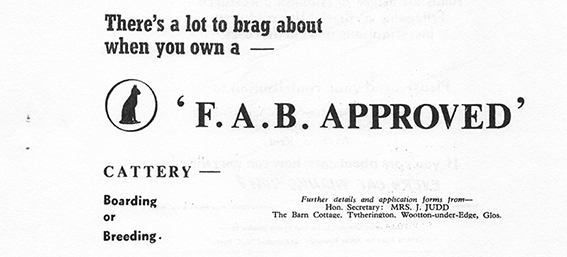
A huge step forward for FAB as a charity came in 1967 when they were able to fund Charles Povey to undertake a research fellowship on feline viral rhinotracheitis at Bristol Veterinary School. This initial fellowship was a huge strain on funds, but its establishment allowed interested veterinary students to study diseases affecting cats, and thus helped to entrench it as a legitimate area of study. It speaks volumes that most feline ‘specialists’ were at one time FAB scholars or received funds from FAB.

Despite all the progress that had already been made and the important work that had already been done, 1971 was a tumultuous year for the charity. Its finances were in disarray, with the scholarship costing more than the amount that was being received in donations, and it was also in this year that Joan Judd decided to step down from her central position due to ill health, though she continued to work closely with the charity. The threat of closure was very real, but a meeting was held with key individuals from the British Veterinary Association, The British Small Animal Veterinary Association and the animal health and pet-food industries, in which new funding was established and a plan to save the organisation was made.
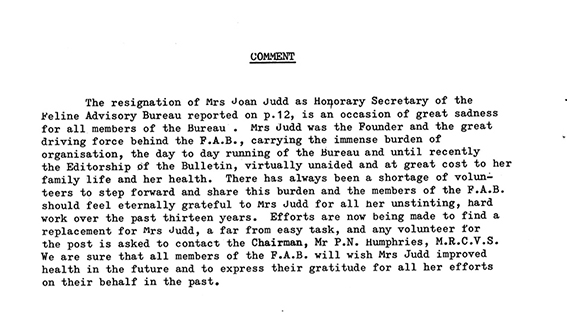
FAB Journal 11 No. 2 October 1971
In the years following, the charity went from strength to strength. The status of the cat as a legitimate field of study led to the rapid discovery of many diseases and conditions affecting cats and FAB retained its place in the centre of all this. The pressure of money was gradually lifted from the charity after several legacies were left, and the charity’s first website in 1990 helped enormously, as it allowed information which had historically been sent out by post to be accessed freely by everyone.
In 1996 the charity formed the European Society of Feline Medicine, which soon became the International Society of Feline Medicine (ISFM), and in 1999 the veterinary journal The Journal of Feline Medicine and Surgery (JFMS) was launched. The impact this had on academic research was huge. Before 1962 there were on average only 3 scientific articles published on feline health per year, now JFMS alone publishes over 1200 pages annually.
In the mid 1990’s Claire Bessant took on the role of chief executive after editing the FAB journal for several years. The office moved to Tisbury in Wiltshire where the charity grew as part time staff were employed, and in the proceeding years, the list of achievements grew. A working coalition of charities and organisations concerned with cat welfare called The Cat Group was formed by FAB to drive collaborative change. The charity held its first European feline medicine conference, which is now run annually along with a conference in Asia-Pacific. ‘The Cat Friendly Clinic’ programme was launched to make visiting the vet a less stressful encounter for cats and owners. Free nurse membership was introduced so nurses could receive the free journal Feline Focus and access free webinars. Intelligent Cat Care was launched as a free magazine that ensured that cat-owners and non-veterinary cat professionals still had access to the latest developments in feline health, welfare and behaviour. The charity also started funding international feline welfare and veterinary training projects across the world and created the ‘Cat Welfare Award’ to acknowledge international efforts to bring a cohesive approach to cat welfare.
In 2013 FAB was rebranded as International Cat Care in light of its achievements and important role in the welfare of cats worldwide. Joan was very supportive of the change and delighted that the charity had flourished as she’d always hoped it would.
Nobody could have predicted that an organisation started by non-vets would have been the catalyst for such enormous change in the field of feline medicine and welfare. The way in which many cats are thought of and cared for today defies comparison with the situation that inspired Joan to form the charity over 60 years ago, but a lot of work still remains to be done in many countries. International Cat Care has continued to grow, and it’s estimated that the charity’s work helps to improve the lives of 25 million cats worldwide. The words that Joan spoke at the formation of the charity were not just a call to arms, but a promise that she kept to cats worldwide, ‘We will not tolerate suffering.’



